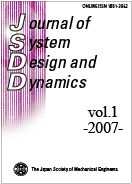Volume 1, Issue 1
Displaying 1-10 of 10 articles from this issue
- |<
- <
- 1
- >
- >|
-
2007 Volume 1 Issue 1 Pages 1
Published: 2007
Released on J-STAGE: March 30, 2007
Download PDF (138K)
Papers
-
2007 Volume 1 Issue 1 Pages 2-13
Published: 2007
Released on J-STAGE: March 30, 2007
Download PDF (2208K) -
2007 Volume 1 Issue 1 Pages 14-26
Published: 2007
Released on J-STAGE: March 30, 2007
Download PDF (885K) -
2007 Volume 1 Issue 1 Pages 27-38
Published: 2007
Released on J-STAGE: March 30, 2007
Download PDF (1971K) -
2007 Volume 1 Issue 1 Pages 39-50
Published: 2007
Released on J-STAGE: March 30, 2007
Download PDF (6241K) -
2007 Volume 1 Issue 1 Pages 51-62
Published: 2007
Released on J-STAGE: March 30, 2007
Download PDF (473K) -
2007 Volume 1 Issue 1 Pages 63-72
Published: 2007
Released on J-STAGE: March 30, 2007
Download PDF (497K) -
2007 Volume 1 Issue 1 Pages 73-84
Published: 2007
Released on J-STAGE: March 30, 2007
Download PDF (529K) -
2007 Volume 1 Issue 1 Pages 85-96
Published: 2007
Released on J-STAGE: March 30, 2007
Download PDF (1200K) -
Free Flexural Vibration of an Elastically Restrained Elliptical Plate Subjected to an In-Plane Force2007 Volume 1 Issue 1 Pages 97-104
Published: 2007
Released on J-STAGE: March 30, 2007
Download PDF (598K)
- |<
- <
- 1
- >
- >|
